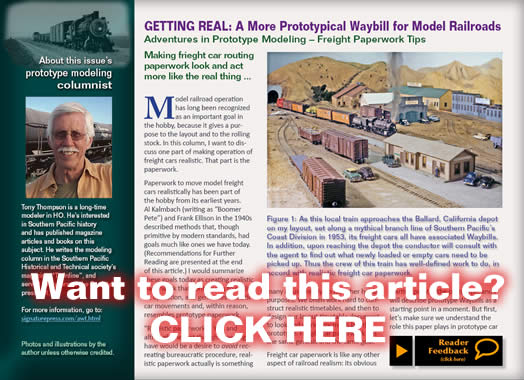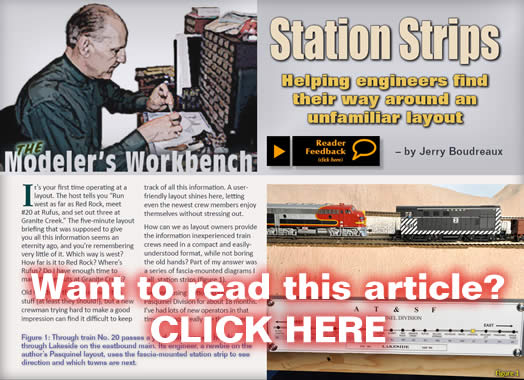Operations

Free rolling cars when switching?
Has anybody tried moving cars during an operating session using either gravity or momentum (REAL momentum, not electrical) instead of keeping them coupled to an engine? I'm talking about kicking cars, dropping them by, jerking them by (flying switches), or other similar operations. Kicking cars is a common practice on the prototype because it drastically speeds the switching. Dropping them by is a great way to get the cars on the other end of the engine without having to run around the train. Jerking them by is VERY discouraged these days, although I have seen

Scratch built structures on the K&EFR
I started building the Kanunda and Emu Flat Railway in 2000 as an operating HO scale model railway layout. I find that operating with appropriate scenery and structures in place is more satisfying that operating on a "plywood pacific". So until recently I have been using temporary structures that I have bought at swap meets or built from kits with little concern to prototype. There are no kits for South Australian line side structures that I know of so I will have to scratch build most of them.

LARGEST COLLECTION OF TRACK PLANS ANYWHERE
Family got table computer for Christmas. It has Google maps app on it. At night while watching TV during commerical I search every rr track in us and every yard etc. The satlitte views are great. You can do track plan just like the real thing. MRH in last issue shows you how to use it great video.
Coupler picks and n scale
In a recent blog posting of mine, the issue was raised about whether it is a good (or even reasonable) idea to use a coupler pick with n scale equipment.
One side seems to say that the use of the coupler pick is just an invitation to derail the cars and promote the need to handle the cars to reset them on the track.
The other side seems to say that there is really no problem.
Another group (not really a side) is saying that magnets are a better approach all together.

My First Ops Session
Well, I've been home a total of 4 days in the last 30 and am off again tomorrow for another 7 before I get to spend 5 straight at home. However, while its been exhausting, while in Connecticut this past week I got two offers to visit layouts. Unfortunately, I couldn't make one due to scheduling but on Saturday I was able to visit rfbranch's layout and take part in my first ever ops session.
Free-moN Staging Yard - 16"x10'
It was showtime at the Hiller.
Silicon Valley Free-moN had our modules set up and trains running only to find...
ONLY ONE PASSING SIDING ON THE WHOLE LAYOUT????
We had over a week of show and the ability to run only two trains at a time?
What would happen next Sunday when the whole group showed up and wanted to run trains?
Draw straws?
Stand in line?
Something had to be done!
So I built (most of) a staging yard in (most of) a week.
OP Session and Open House
Guys: I am hosting a Clinchfield OP Session this next Saturday starting at
11 am. Date is April 28th at my home. If we have enough operators we should be able to run a regular summer
1975 schedule.
How Did 1940s Industry (or R.R.) Switchers Use Runarounds?
Reading Lance Mindheim's Industrial Switching Primer for modern era.
I'm modeling mid 1940s and would like to know how use of a runaround
to get around the other end of the train was used.
The reasons Lance gives in his book for NOT using runaround tracks (passing sidings)
are time and cost related and would seem to make sense in earlier eras as well...BUT
labor was much cheaper then.
How much of this summary would apply to '40s era industrial switching?
Also would it vary for classification yards much?
"Real railroads go to great length to avoid runarounds.
>> Posts index
Navigation
Journals/Blogs
Recent Blog posts:

